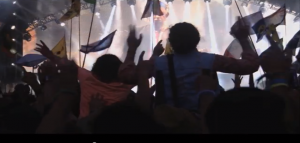Art Everywhere for Everyone
Five leading US art galleries selected works of art that represent American history and culture. The public voted for their favourites, and the final selection of 58 works are appearing across the country on billboards, bus shelters, subway posters, buildings and other public places.
The exhibition is inspired by Art Everywhere founder, Richard Reed who first produced Art Everywhere UK. Both shows are running until the end of August to make this into the biggest art exhibition ever.
Reed describes the inspiration behind the show”
“I used to walk across Shepherd’s Bush Green and on a poster site someone had put up a beautiful picture. There was no logo; it wasn’t an advert. It was really mysterious, but it was a beautiful thing to see and I would stop and look at it for 30 seconds on my way into work. It just gave you a bit of lift.
I was telling my wife about this and she said, imagine what it’d be like if there were things like that everywhere. What would it be like if all the posters across the country for two weeks showed art not advertising? So we went to the big poster companies and said this is our idea – to turn the UK into the world’s largest outdoor gallery for two weeks.
And they loved it and decided they wanted to work together as an industry to make it possible: we’ve called it Art Everywhere.”
Read More
Rolling Stones Headline at Glastonbury
home to Glastonbury Abbey, one of the most important abbeys in England.
It’s also a town which attracts thousands of people interested in New Age or Pagan beliefs largely because of the myths and legends related to Glastonbury Tor.
These include references to the Holy Grail, King Arthur and Joseph of Arimathea, with some Arthurian literature identifying it as the legendary Island of Avalon.
Glastonbury Festival of Contemporary Performing Arts
Internationally Glastonbury is best known as home to the most famous music festival in the world – The Glastonbury Festival of Contemporary Performing Arts which includes dance, comedy, theatre, circus, cabaret and other arts as well as contemporary music.
Festival organiser Michael Eavis is a local farmer who was inspired after seeing the open air Led Zeppelin concert at Bath Festival of Blues and Progressive Music, 1970 to host an open air festival on the the farm. 14 people invested everything they had to build the stage (many told them the idea would never catch on). The first festival was in 1970 – and the rest as they say, is history.
Rolling Stones Live at Glastonbury 2013
The Rolling Stones headlined the Pyramid Stage, playing to a crowd of over 170,000 (not bad for a group that has been around for 50 years).
Their gig started around 9.45 pm at the end of a beautifully sunny day in Somerset with the crowd waiting in electric anticipation for the most high profile act ever to perform at Glastonbury (having taken 43 years to get there) .
The Stones played a twenty song set including a version of “Factory Girl” which with specially adapted lyrics became “Glastonbury Girl”
“It was one of the greatest rock and roll sets I’ve ever seen in my life and I think one of the greatest rock and roll sets Glastonbury has ever seen”. “They really just rocked it. The band seemed almost as impressed as the crowd. I guess the audience makes the gig as much as the band.” Telegraph music critic Neil McCormick
Rolling Stones Glastonbury Song List:
‘Jumpin’ Jack Flash’
‘It’s Only Rock ‘N Roll (But I Like It)’
‘Paint It, Black’
‘Gimme Shelter’
‘Glastonbury Girl’
‘Wild Horses’
‘Doom And Gloom’
‘Can’t You Hear Me Knocking’
‘Honky Tonk Women’
‘You Got The Silver’ ‘Happy’
‘Miss You’
‘Midnight Rambler’
‘2000 Light Years From Home’
‘Sympathy For The Devil’
‘Start Me Up’
‘Tumbling Dice’
‘Brown Sugar’
‘You Can’t Always Get What You Want’ ‘
(I Can’t Get No) Satisfaction’
What the Posters Say
An interesting article by musician and writer, Anya Pearson looks at festivals as an annual yardstick of Britain’s musical talent. By taking the much publicised Festival Posters and editing out all acts represented on the posters that do not include at least one female musician, she turns them into a barometer of gender equality in 21st Century Britain. “As a female musician currently in two mixed-gender bands, I have always been painfully aware of my minority status in the music scene.” she says.
Glastonbury 2013 Poster showing music acts appearing at the festival

Glastonbury 2013 Poster – showing only acts that include
at least one female musician (34%).

Glastonbury was not the worst offender for failing to represent female musicians, probably thanks partly to co-organiser of the event, Emily Eavis, but its poster still only had 34% of the acts that included female musicians.
Bestival 2013 Poster showing music acts appearing at the festival

Bestival 2013 Poster showing only acts that include
at least one female (21%)

Reading and Leeds 2013: Poster showing music acts appearing at the festivals

Reading and Leeds 2013: Poster showing only music acts appearing at
the festivals which include at least one female (17%)

Pearson concludes:
“Still, festivals alone are not to blame: promoters, managers and record labels all play their part. As a society we are less encouraging of girls who aspire to headline Glastonbury. I was lucky. My mother is a musician who started out in the 70s and always told me my XX chromosome was no barrier to making music.
That said, there are lots of brilliant female musicians out there – as Yoko Ono’s Meltdown at the Southbank Centre proved. Women aren’t passive consumers of popular culture – we just often lack a creative platform to showcase what we can do.”
http://www.glastonburyfestivals.co.uk/
http://womensliberationmusicarchive.co.uk/
http://www.southbankcentre.co.uk/whatson/festivals-series/yoko-onos-meltdown/
http://www.guardian.co.uk/commentisfree/2013/jun/26/glastonbury-festival-few-women-artists
Read More




